Triclocarban (TCC), a commonly used antibacterial agent in various personal care products, has emerged as a significant environmental pollutant with potentially dire implications for cardiovascular health. Recent findings have shed light on the alarming impact of TCC exposure, particularly regarding its role in myocardial hypertrophy—a condition intricately linked to severe cardiovascular diseases, including heart failure. Heart failure represents the final common pathway for a range of cardiovascular disorders, characterized by pathological changes in cardiac tissue, particularly hypertrophy. As the scientific community endeavors to unravel the multifaceted etiology of heart failure, TCC’s impact cannot be overlooked, particularly in the context of an increasingly polluted environment.
As concerns grow regarding environmental pollutants, the role of antimicrobial agents like TCC poses new questions. The rising prevalence of heart diseases is being scrutinized in the light of environmental exposure to various chemicals traditionally not associated with cardiovascular conditions. TCC, with its broad-spectrum antibacterial properties, is often found in everyday products like soaps, detergents, and cosmetics. This widespread use has rendered TCC not only a household name but also one of the most prevalent water pollutants globally. Strikingly, post-pandemic inventories indicate an exponential increase in the release of such antimicrobial agents into our ecosystems, leading to urgent calls for attention from public health experts.
One of the critical insights gleaned from recent studies is the propensity of TCC to accumulate within environmental reservoirs. Its high lipophilicity—the tendency of a chemical to partition into fats rather than water—means that it not only remains in ecosystems longer but can also bioaccumulate within various organisms, including humans. While the precise pathways through which TCC influences human cardiovascular health remain obscure, there is growing evidence linking this compound to the onset of coronary heart disease in population studies. Laboratory studies have echoed these findings, with animal models indicating TCC’s toxicity to cardiac tissue. Thus, the quest for clarity surrounding TCC’s effects on human heart health is both pressing and essential.
To address these knowledge gaps, researchers have turned to human cardiac organoids—tiny, simplified models of human heart tissue derived from induced pluripotent stem cells. This innovative approach allows for a more nuanced investigation of the complex interactions between TCC and cardiac biology, mitigating the ethical concerns associated with traditional animal experimentation. These organoid models effectively mimic critical aspects of human cardiac physiology, providing a relevant platform to assess how environmental contaminants like TCC influence cardiovascular function and pathology.
The findings from studies using human cardiac organoids revealed that exposure to TCC at environmentally relevant doses induced significant hypertrophic and metabolic changes. It became evident that the endothelial cell metabolism plays a crucial role in the development of pathological hypertrophy. Notably, this study highlighted the progressive nature of the changes induced by TCC exposure, with alterations in endothelial metabolism occurring prior to any overt myocardial injury. Such results underscore the importance of timely interventions aimed at safeguarding endothelial function to mitigate the potential onset of hypertrophy.
At a cellular level, TCC exposure disrupts the delicate balance of nitric oxide (NO) production by affecting arginine metabolism in endothelial cells. As the concentration of TCC increases, there is a marked elevation in the production of reactive oxygen species (ROS) and inducible nitric oxide synthase (iNOS)—two factors intimately linked to oxidative stress and inflammation. This disturbance results in endothelial dysfunction, a precursor to a host of cardiovascular complications, including myocardial hypertrophy. Therefore, understanding these molecular mechanisms becomes paramount in devising strategies to combat the adverse effects of such pollutants.
Moreover, the implications of these findings extend beyond the laboratory. With increasing public awareness about the risks associated with environmental toxins, there is a growing demand for regulatory reforms and safer product formulations. As scientists continue to elucidate the pathways through which TCC influences cardiovascular health, it becomes crucial for policymakers and industry stakeholders to collaborate on developing more stringent guidelines that limit the use of harmful antimicrobial agents in consumer products.
As we navigate this complex landscape, the intersection of environmental science and public health remains pivotal. The ongoing research surrounding TCC and its cardiovascular effects highlights an urgent need for more comprehensive studies that explore the long-term implications of exposure to such pollutants on human health. Creating awareness among consumers regarding the potential risks associated with everyday products could foster more informed choices and eventually lead to a significant reduction in exposure.
Ultimately, the narrative around TCC is not merely academic; it reflects an urgent call to re-examine the substances we often take for granted in our daily lives. As we confront the reality of escalating environmental pollution, the imperative to understand and mitigate the health repercussions of contaminants like TCC becomes increasingly critical. This research not only sheds light on a pressing health concern but also underscores the need to adopt preventive measures that can protect both human health and the environment.
In conclusion, the intersection between environmental pollutants and cardiovascular health is becoming a focal point in contemporary research. TCC’s ability to instigate myocardial hypertrophy through endothelial dysfunction underscores the necessity for both scientific inquiry and public health vigilance. As investigations into the mechanisms of action continue, it is imperative that we remain cognizant of the products we use and their potential impacts on our health. As the field evolves, so too must our strategies to mitigate risk and safeguard our well-being in an increasingly polluted world.
Subject of Research: The impact of Triclocarban (TCC) exposure on cardiovascular health and myocardial hypertrophy
Article Title: Triclocarban Exposure and Its Implications for Cardiovascular Health
News Publication Date: TBD
Web References: TBD
References: TBD
Image Credits: ©Science China Press
Keywords: Triclocarban, myocardial hypertrophy, cardiovascular health, endothelial dysfunction, environmental pollutants, nitric oxide, reactive oxygen species, human cardiac organoids.




